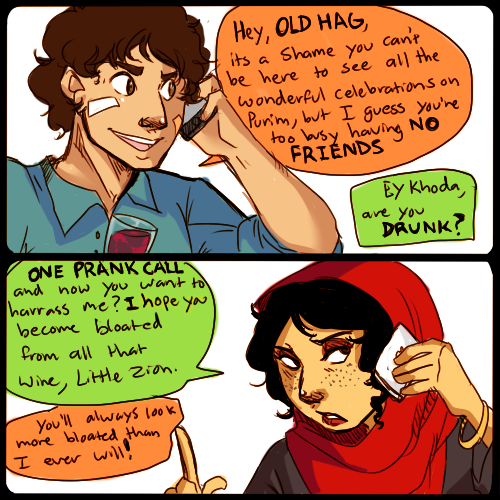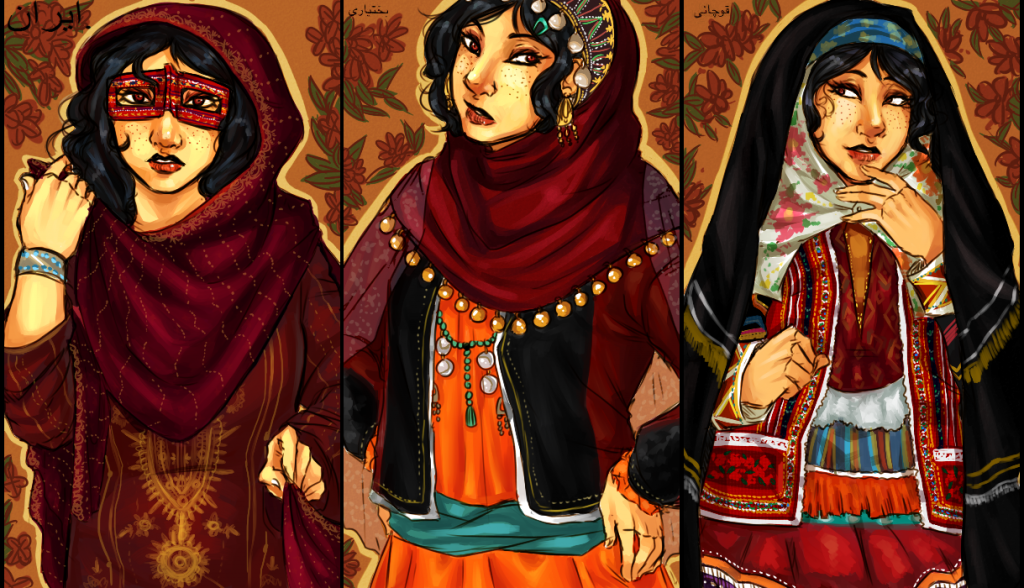A guest post by Holly Dagres, an Iranian-American analyst and commentator on Middle East affairs. Currently living in Egypt, she is a researcher at the Cairo Review of Global Affairs and finishing her master’s degree in political science at the American University in Cairo. Her research interests include: post-colonialism, feminism, the Diaspora, revolutions, Islamism, diplomacy and foreign policy. You can read more by Holly Dagres on her website or follow her on Twitter @PoliticallyAff
I have often wondered if countries were people, what gender would they be, and in particular, what kind of personalities would they possess? In the case of Iran, I always imagined it to be feminine – a ‘she’. Partly because in nationalist discourse, Iran is associated with being female – “Mother Iran” – but also because it is shaped like a cat. During the 1940s, much of the illustrated representations of the nation of Iran was of a maternal figure and that continues to be the case today.

As I pondered these possibilities, a cartoonist on Tumblr came to my rescue. Her blog is called ‘Ay Dokhtare,’ which translates as Hey Girl. Also known as ‘Ask Iran,’ Ay Dokhtare is one of the most popular cartoon blogs on Iran to date. The Tumblr offers a weekly cartoon analysis of various questions readers ask, which is anything from, “Do you think Israel and America have a little something-something going on?” to “What languages are spoken in Iran?”
Ay Dokhtare declares, “In light of all this mess America has been spreading about me, I, the beautiful Islamic Republic of Iran, have come to enlighten you all. Feel free to ask me what you so desperately need to know!”
Ay Dokhtare tells the story of ‘Iran,’ also known as Roshanak, in the form of cartoons. She flirts with Turkey, pokes fun at paranoid little Israel, and in the process explains the profound history and culture of the country with informational blog posts.
The mastermind behind Ay Dokhtare is 20-year-old Salvadorian-American Sophy, who has an academic love affair with history. What makes her work even more unique is that Sophy is completely self-taught, and despite not yet having attended university, she has taken education into her own hands and built a private library that would be the envy of any student of Iranian Studies. Sophy works full-time and with her biweekly checks, rushes to buy more books on the topics of Iran and the Middle East, to not only educate herself but her audience as well. Despite this, the illustrations are gorgeous, combining various artistic styles to offer a visually stunning whole.

The idea for Ay Dokhtare came from a trend of personification – which is a major theme amongst Tumblr accounts – that add human attributes to otherwise non-human entities. This type of illustrative personification of countries is inspired by the Japanese web comic, Axis Powers Hetaila, which deals with countries in a lighthearted matter.
Much of the personified characters in this trend of medium tend to be European, leaving an empty space for representations of Middle Eastern peoples. Sophy seized the opportunity to personify Iran, a country whose profile is often defined in the West through a strictly political lens with bouts of Orientalism, even though politics itself cannot be separated entirely from it.
By personifying Iran, there is a human element that consists of a face, body, voice, and gender. In Roshanak’s mind, she must cope with being a country and a nation. As Sophy points out, she deals with victories and defeats, changing sociopolitical landscapes, the deaths of her leaders, missing her Diaspora, and dealing with feelings regarding politics she enacts on behalf of her governments, from old dynasties to the current Islamic Republic.
Much of what Sophy portrays of Iran is the result of not only her independent research of its history, but also from cultural input and collaborations with her Iranian friends. Aspects of Roshanak’s personality and even her aesthetic are drawn from Iranians Sophy has come across over the years. Each illustration, meanwhile, is followed by an extensive explanation and analysis of the topics covered, offering academic and intellectual insight in addition to graphic beauty.
In addition to Iranian influences, a lot of her inspiration and knowledge draws from Middle East historians, the likes of Nikki Keddie, Janet Afary, Hamid Naficy, Afsaneh Najmabadi, and Edward Said.
Sophey’s Tumblr is not only insightful, but also brings a touch of humor to the stereotypical Iran with which people tend to associate. Although Sophy has never visited Iran, she dreams of the day when she will see Tehran during the wintertime and Shiraz’s tulip fields at the start of Nowruz, the Iranian New Year.

While graphic cartoons have been around for about 25 years, some of the more prominent ones tend to tackle political issues, such as Art Spieglman’s Maus and Alan Moore’s V for Vendetta. This evolving genre has opened the door for more graphic artists to capture important issues and cultures pertaining to the Middle East and North Africa such as Joe Sacco’s Palestine and Marjane Satrapi’s two-part graphic novel memoir, Persepolis I & II, which helped first bring attention to Iran’s avant-garde history and was later Oscar-nominated for best animated picture.
Through this novel form of expression from the Iranian Diaspora, Persepolis gives a narrative of a country without an open voice to the rest of the world, providing readers with the ability to access a place most do not have the ability or means to visit, by providing insight to its profound cultural and political history.

Amir and Khalil’s Zahra’s Paradise works in a similar matter, but instead attempts to draw attention to Iran’s deteriorating human rights caused by the repression of the 2009 post-election protests known as the Green Movement. In the weeks leading up to the 2013 presidential election in Iran, Zahra’s Paradise turned into a virtual campaign for the candidacy of a 52-year-old cartoon woman whose namesake is Zahra. As its website claims,
“The purpose of this virtual campaign is to create a collaborative space for the voice, vote and vision of the Iranian people. Zahra’s campaign seeks to confront a corrupt and criminal theocracy—one founded on fraud, fear and force—by offering an antidote: an alternative candidate committed to advancing the movement for democracy, dignity and equality in Iran, a movement dating back to the constitutional movement of 1906.”

Unlike Zahra’s Paradise, Sophy’s work takes a softer, if not different stance in the longstanding narrative on Iran by attempting to shatter dominant views in the media collective. What is most intriguing is how Sophy makes an impact of her own by engaging people to literally, Ask Iran, something that has not been done before. Some of the questions Roshanak gets can be silly, but essentially they are simple and generally amusing for an audience concerned with the escapades a country might have when not engaged in political issues, such as Iran’s feelings about its neighbors – Turkey, the UAE, and so forth – in the region.
Sophy initially did not create the blog with the intent of delivering a particular message, but rather to provide a source of entertainment and a means to answer questions in a humorous way. She then realized she needed to take into consideration that by representing a country like Iran, she should include information and educational tidbits within Roshanak’s answers to dispel some of the myths that a Western-oriented audience might hold. One such example is when old sentiments of the Iranian Hostage Crisis were aroused again in the recent Oscar-Winning film Argo (2012), which allowed for a retelling of history by depicting manic, bearded men chanting, “Death to America,” offering moviegoers a tainted picture of what the Islamic Republic of Iran is really like today.
Moreover, the ongoing Western media’s emphasis on the intentions of the Iranian regime’s controversial nuclear program caused the international community to become intrigued with the Islamic Republic all over again. People often forget Iran was not always an Islamic Republic and has a profound history of at least 4,000 years. In Sophy’s sketches, Iran is not solely the personification of the current Islamic Republic, but an amalgamation of all her polity and discourse; her diversity of cultures, languages, and religions; and the complex history that surrounds the country of Iran.

In all these realms, there are many narratives that exist in Iran. Thus the task of personifying her risks marginalizing some of these narratives, since many outsiders imagine Iran as simply: ‘The Persian,’ ‘The Shiite Muslim,’ and in prejudicial cases, the ‘Islamic Extremist.’ With this in mind, Sophy attempts to break stereotypes through her blog.
In the world of mass media, political cartoons are able to convey visual messages that in many instances critique and depict satire in a way the mainstream media cannot verbally express, challenging dominant narratives. Oftentimes, such cartoons question norms and provide an education in basic common sense, which is why many people enjoy sharing these animated depictions of the world around us. Moreover, political cartoons can change a person’s feelings on a certain issue in addition to other things, as noted by Samuel Grompers’ Papers:
“Political cartoons are not just entertainment– they are an engaging form of historical evidence. Produced for a specific reason and directed to a particular audience, political cartoons were designed to shape public opinion, support a cause, expose an opponent to public scorn, or caricature a person’s beliefs, motivation, or significance, among other things.”

Although ‘Ask Iran’ is still fresh, it is making a major impact online. By showcasing Iran’s culture, history, and supposed ‘personality,’ Sophy is adding to the conversation by giving the Iranian people a voice needed during a time when sanctions are exacting a heavy price on Iranians and there is an ever-present fear of war. Her discourse is an extremely important contribution to the dialogue on Iran in the face of ‘othering,’ which is in line with Orientalist stereotypes of the Iranian people as being angry, backwards, and terrorists.
It is under this guise that independent cartoons and graphic novels on the Middle East and North Africa are the key to eradicating myths about the Orient, especially when it comes to reaching a diverse and universal audience in the fact-paced age of social media. Hopefully more people will listen to ‘Iran,’ and ask her how she feels, before repeating the mistakes of the Iraq War – on Iran.
For more of Sophy’s illustrations, check out the Ask Iran Tumblr here.











3 comments
First of all, most countries if not all are referred to as FEMALE and as mother lands. Secondly, a cat
as you know can be male or female. So I am wondering how she arrived at such a conclusion ONLY about Iran.
Loved Ms. Sophy’s work. Fascinating way to present a complex topic–and with nuance, too. Thank you for sharing this gem!